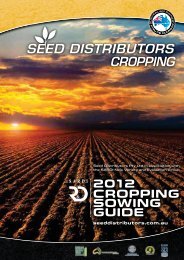2011 LUCERNE TECHNICAL ADVISOR - Seed Distributors
2011 LUCERNE TECHNICAL ADVISOR - Seed Distributors
2011 LUCERNE TECHNICAL ADVISOR - Seed Distributors
Create successful ePaper yourself
Turn your PDF publications into a flip-book with our unique Google optimized e-Paper software.
Lucerne Technical Advisor<br />
Lucerne - Pests and Diseases<br />
Phytophthora Root Rot - Phytophthora medicaginis<br />
Description: Plants turn yellow, wilt and die. Areas of light brown discolouration up to 5 cm long occur on<br />
the taproot up to 30 cm below the crown. The Taproot below the discoloured area will rot away completely.<br />
Incidence: Occurs throughout Australia, particularly in heavy and/or poorly drained soils, and in wet<br />
conditions. The disease can be severe, killing large numbers of seedlings or scattered plants or large patches<br />
in mature seeds. In irrigated stands plants can survive. The taproots immediately below the crown is kept<br />
alive by the availability of water but forage yields are reduced.<br />
Spread: The fungus spreads rapidly in water over considerable distances.<br />
Management:�������������������������������������������������������������������������������������������<br />
������ Avoid waterlogging irrigated stands on heavy soils.<br />
Colletotrichum Crown Rot or Stem Anthracnose - Colletotichum trifolii<br />
Description: ��������������������������������������������������������������������������������������������<br />
25 mm long, dark around the edges with pale centres, and covered in raised dark spots. The fungus can also<br />
enter the crown causing a blue-black discolouration, 5 - 8 cm into the taproot. In mature stands, the dead<br />
stems are white or straw coloured with a sheppard’s crook appearance. Plant death occurs gradually.<br />
Incidence: Occurs throughout Australia in warm environments with high humidity. It is more severe during<br />
late summer to autumn. It is less likely in drier and cooler climates.<br />
Spread: Spores spread in warm, wet weather from plant debris and from the crown of infected plants by<br />
�����������������������������������������<br />
Management:��������������������������������������������������������������������������������������������<br />
the crop every three years with non-host plants.<br />
��������<br />
Spotted Alfalfa Aphid (SAA) - Therioaphis trifolii<br />
Description:����������������������������������������������������������������������������������������������<br />
��������������������������������������������������������������<br />
Damage:�������������������������������������������������������������������������������������������������<br />
that can kill seedlings and mature plants. Prior to that, leaf veins become yellow or white and the leaves curl<br />
��������������������������������������������������������������������������������������������������������<br />
Incidence: Occur throughout Australia in dry conditions, mainly in the spring and autumn.<br />
Management:����������������������������������������������������������������������������������������������<br />
��� SAA numbers. In irrigated hay stands, use insecticides if the infestation is heavy.<br />
Bluegreen Aphid (BGA) - Acyrthosiphon kondoi<br />
Description: Adults vary from pale green-grey to dark green-blue and are 3 mm long and have tube-like<br />
���������������������������������������������������������������������������������������������������������������<br />
Damage: Adults and nymphs suck sap from the leaves and stems at the growing points, causing shortened<br />
internodes between the leaves at the top of each stem, stunted plants, leaf curling and leaf yellowing.<br />
������������������������������������������������������������������������������������������������������<br />
mature plants.<br />
Incidence:�������������������������������������������������������������������������������������������������<br />
Management: �������������������������������������������������������������������������������������������������<br />
���<br />
numbers. In irrigated hay stands, use insecticides if the infestation is heavy.<br />
Pea Aphid (PA) - Acyrthosiphon pisom<br />
Description: Green in colour, though some may be yellow or pink. They are 4 - 5 mm long with dark bands<br />
around the antennae and spine-like projections on both sides at the rear of their bodies. Adults may have<br />
���������������������������������������<br />
Damage: PA suck sap from the leaves causing wilting, stunting and curling, and odd-shaped plants.<br />
���������������������������������������������������������������������������������������������������������<br />
��������������������������������������������������������������������������������������������������������<br />
Incidence:�������������������������������������������������������������������������������������������<br />
in spring and autumn,although economic levels of damage are rare.<br />
Management:��������������������������������������������������������������������������������������������<br />
����������<br />
hay stands, use insecticides if the infestation is heavy.<br />
Stem Nematode - Ditylenchus dipsaci<br />
Description: Microscopic eel-worms that are individually difficult to see with the naked eye. Sometimes they<br />
mass on or just below the surface to form visible ”eel-worm wool”. These can survive desiccation and be<br />
transported in hay to start new infestations.<br />
Damage: Plants are dwarfed and distorted, with swollen shoots.<br />
Leaves are distorted and clustered towards the ends of stems. Plants die in patches.<br />
Incidence: Occur in southern Australia, common in irrigated stands<br />
on river flats, with greatest severity in the spring.<br />
Management: Sow resistant varieties, plough out badly infested stands and practice crop rotation<br />
S Orloff<br />
Bacterial Wilt - Clavibacter michiganense ssp.insidiosus<br />
Description: �����������������������������������������������������������������������������<br />
����������������������������������������������������������������������������������<br />
Incidence:����������������������������������������������������������������������������������������������<br />
It often occurs in autumn in irrigated stands. It is not found in the dry, inland subtropics of Queensland and<br />
�������������������������<br />
Spread: The bacteria persist in soil for more than 10 years.<br />
��� The disease is spread by stem nematodes and through hay and machinery.<br />
Agriculture Management: Sow certified seed of resistant varieties.<br />
Fusarium Wilt - Fusarium oxysporum f.sp.medicaginis<br />
Description: Initially, plants are stunted with wilted shoots and yellow leaves.The infection then bleaches the<br />
�����������������������������������������������������������������������������������������������������������<br />
at the base of the stem forming a reddish-brown ring in the centre of the root.<br />
Incidence: Fusarium wilt is not common. The Fusarium fungus is widespread, but rarely causes wilt. Fusarium<br />
������������������������������������������������<br />
Spread: The fungus survives for long periods in decaying plants. It invades small roots or wounds in the<br />
taproot during warm, wet weather.<br />
������<br />
Management: ����������������������������������������������������<br />
14<br />
SEED DISTRIBUTORS l <strong>2011</strong>��������������������������




